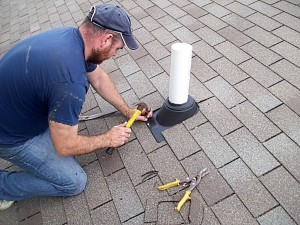According to the University of Iowa, the state has the highest average for indoor radon levels in the country. That should be alarming to Iowa residents considering radon gas is the second leading cause of lung cancer in the nation, responsible for the deaths of more than 21,000 each year.
The biggest problem with radon gas is that it’s odorless, colorless and tasteless — meaning it’s virtually undetectable. Most homeowners or residents have no idea the gas is even lurking about. In fact, the only way to discover whether or not its a problem is to test specifically for it. Luckily, you can purchase a DIY testing kit for relatively cheap ($10 – $20) at any local hardware store or online. However, if you never test your home, you’ll never know it’s killing you.
Iowa May Require Builders to Pre-Install Radon Mitigation Systems
 That may soon change, as the Iowa Senate will be weighing in on legislation that requires builders to integrate radon mitigation systems in all new homes. This is done by running a series of pipes under the foundation, which are then connected to a fan that pumps the gas out and away. In some cases, if the radon mitigation system detects elevated levels of radon, then it will automatically activate the fan and clean out the home. In others, it runs constantly and keeps the home radon free at all times.
That may soon change, as the Iowa Senate will be weighing in on legislation that requires builders to integrate radon mitigation systems in all new homes. This is done by running a series of pipes under the foundation, which are then connected to a fan that pumps the gas out and away. In some cases, if the radon mitigation system detects elevated levels of radon, then it will automatically activate the fan and clean out the home. In others, it runs constantly and keeps the home radon free at all times.
Of course, these pre-built radon mitigation systems will not include the fan. Instead, builders will run the pipeline as described. Later, if the homeowner discovers elevated levels they can have a fan installed which is much cheaper than installing a radon mitigation system from scratch.
For comparison, new radon mitigation systems cost anywhere from $1,200 to $2,500 depending on the size of the structure and who installs the setup. In other words, it could save homeowners about $1,000 should they discover elevated levels exist in their home at a later date.
Not only would this help new homeowners protect themselves and their families, it will also show everyone that it doesn’t matter what kind of home you live in — they are all susceptible. New homes, old homes, homes with basements, homes without, apartments, manufactured homes; they are all susceptible to radon gas.
Radon Mitigation Is Necessary to Protect Against Elevated Levels
Radon is a naturally occurring radioactive gas that is released by elements such as Uranium, which are commonly found in the soil and rock underneath our feet. Once it seeps up from the surface it can enter homes, apartments or residences through cracks in the foundation, walls or flooring. Because the gas is so dense, it collects in great abundance — generally in lower levels of a home. That said, it can and will spread and that includes to first and second story homes even where there is a basement below.
Location doesn’t matter either. While some areas — such as Iowa — are more prone to the issue, radon gas exists everywhere. From greater New England, all the way down to Florida. From the Carolinas, all the way west to Cali. It’s not just a problem here in the US either. Other countries such as Canada, the UK and even Ireland have problems with the silent and deadly gas.
So, this bill under consideration in Iowa should truthfully be considered everywhere in the country. It’s enough that homeowners have to worry about various hazards like mold, mildew, toxic paints and chemicals and hazardous materials. Time and time again, we’ve continuously seen negligent builders who are not concerned with the health and wellness of the families that will be living in these homes, but instead their own coffers. Isn’t it time we started protecting ourselves from these glaring dangers? In the case of radon, have a mitigation system primed and ready to go in new homes — should radon gas rear its ugly head — is an exceptional idea.
Via: Iowa Public Radio



